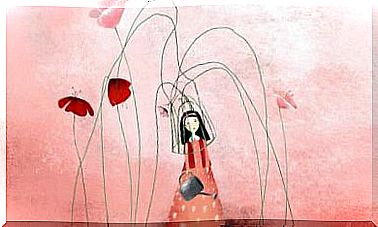The Fable Of Stones: How To Manage Our Worries?

A teacher at an institute for adults wanted to teach. Many of them did not have enough time to study, alternated classes with their jobs and faced many difficulties. The money was not enough. Some were married, had children, felt overwhelmed by responsibilities. So, the teacher decided to present them the fable of stones.
Some students didn’t even want to hear it. It seemed, in a way, like a waste of time. They were more interested in advancing the content than listening to the fable of stones. After all, they were adults and didn’t need anyone to try to teach them how to live.
Despite the resistance of the students, and precisely because of it, the teacher insisted on teaching the day’s lesson. What he did was to take a glass jar and place it on the table. Then he took several stones from under the table and placed them near the jar. Then he asked the students if they thought that, with the stones, the jar would fill.
The Fable of Stones Experiment
Students began to make assumptions. Each one estimated the amount of stones that would fit into the jar and decided whether it would be possible to fill it or not. In the end, almost everyone agreed that, in fact, the stones were big enough to fill the space. Thus began the experiment in the fable of stones.

The teacher inserted the stones one by one. When finished, they reached almost the top of the jar. Then he asked the students: “is the jar full?” Almost everyone said yes. Then, the teacher removed from under the table a small container containing smaller stones. He asked if it was possible for these stones to fit inside the jar. The students thought about it for a while and said yes.
The teacher placed them little by little, until the container was empty. Again he asked the students: “is the jar full?” Students analyzed in detail. After verifying that there was no room for anything else, they replied that yes, it was already full.
There is always room for more
Although everyone thought it was impossible to introduce anything else into that jar, the professor again intrigued them. This time he took out a bag. There was sand in it. Silently, he began to pour it into the jar. To everyone’s surprise, the sand made its way through the jar’s contents. Students did not take into account that between the stones there is always a small space.
For the fourth time, the teacher asked again, “Is the jar full?” This time, without hesitation, the students answered yes. It was impossible to introduce anything else. The few spaces that were left had already been filled with sand.

The teacher picked up a bottle filled with water and began to turn it over the jar, which was already filled with large stones, small stones, and sand. The content didn’t overflow. This meant that there was still room for water, even though everything was full. The sand was getting wet and a good part of the liquid entered. When he finished, the teacher asked, “What did you learn from this?”
The moral of the fable of stones
When the teacher asked the question, one of the students quickly perked up to respond: “What this fable teaches us is that no matter how many things you have on your agenda, there will always be space to put something else on it. Everything is a matter of organization”.
The teacher was silent. Another student also wanted to participate. He said that the teaching was infinite, that you can put more and more things in your head, as if you were the recipient. After all, you can always add something else.
Seeing that the students had not understood the experience of the fable of stones, the teacher took the floor. This time, he asked them: “What would have happened if I had done everything backwards? If it had started with water, until it reached the larger rocks?” The students responded that the jar would have overflowed quickly.
“Now you understand,” said the professor. “Water, sand, small and large stones are the problems. Some are big, some are small, and some are barely noticeable. If we start to address the big issues first, there will be room for the small issues. However, if we do it the other way around, we won’t solve anything”. This is what the fable of stones teaches: start first by solving the big concerns, otherwise the little ones will make everything boil over.









